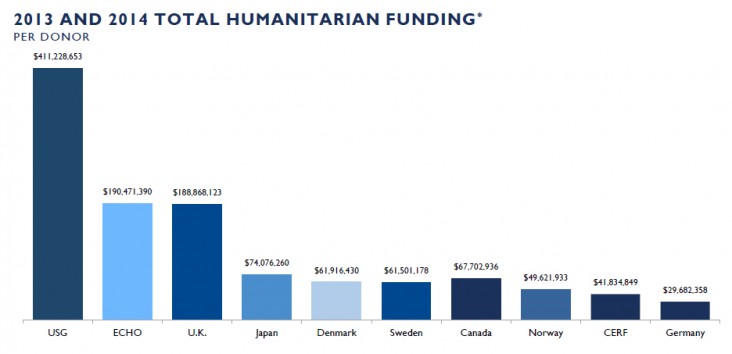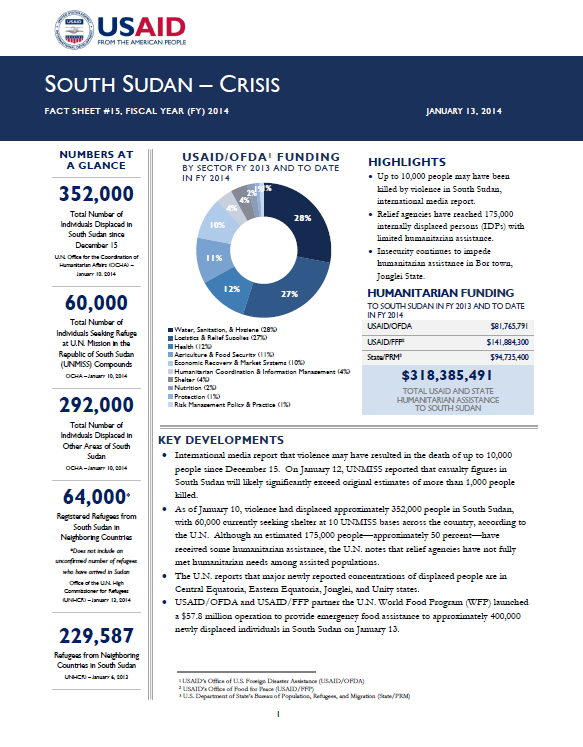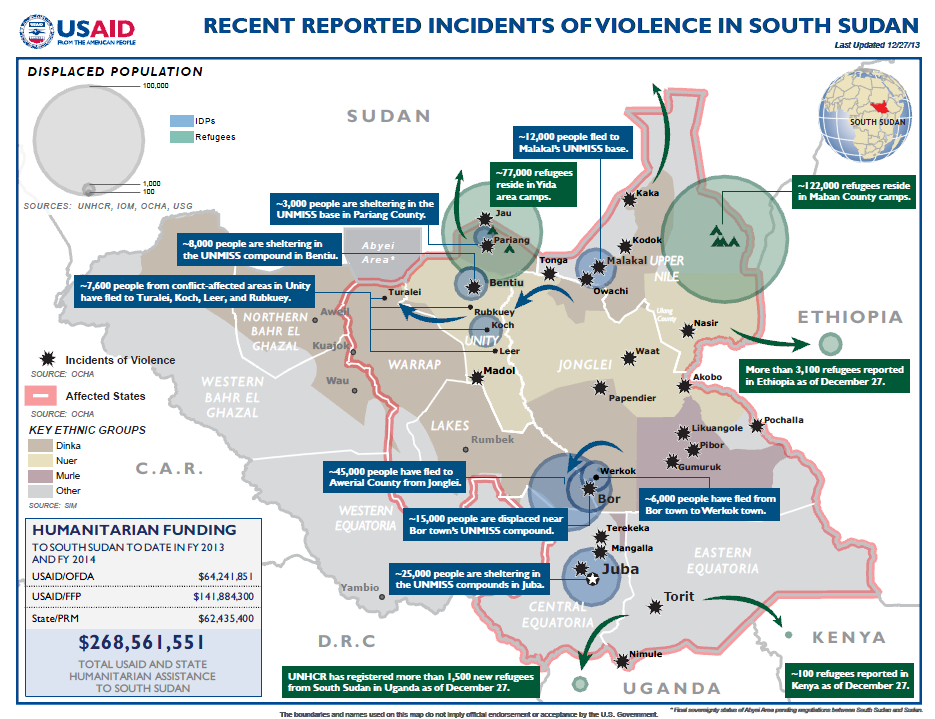- What We Do
- Agriculture and Food Security
- Democracy, Human Rights and Governance
- Economic Growth and Trade
- Education
- Environment and Global Climate Change
- Gender Equality and Women's Empowerment
- Global Health
- Humanitarian Assistance
- Transformation at USAID
- Water and Sanitation
- Working in Crises and Conflict
- U.S. Global Development Lab
Speeches Shim
January 27, 2014
Numbers At A Glance
575,500
76,100
499,400
112,200
229,600
Humanitarian Funding:
To South Sudan To Date In FY2013 and FY2014:
| USAID/OFDA | $81,765,791 |
| USAID/FFP | $141,884,300 |
| State/PRMDoD | $94,735,400 |
| TOTAL | $318,385,491 |
Highlights
Despite the cessation of hostilities agreement signed on January 23, insecurity persists in Lakes, Jonglei, Unity, and Upper Nile states.
Humanitarian organizations suspend operations in Awerial County, Lakes.
Relief agencies provide limited humanitarian assistance to more than 251,000 people.
KEY DEVELOPMENTS
Insecurity and fighting continue to severely affect communities and impede humanitarian access across South Sudan, with violence displacing more than 687,700 people both internally and as refugees to neighboring countries as of January 23, according to the U.N. More than 76,000 people—the highest figure recorded since violence erupted on December 15—are sheltering at eight UNMISS bases throughout South Sudan, including approximately 27,000 people in Malakal town, Upper Nile, and nearly 36,000 people in the two UNMISS bases in the capital city of Juba, Tong Ping and U.N. House 3.
Recent fighting in Lakes prompted more than 100 aid workers to relocate from Mingkaman town, Awerial, to Yirol town, Yirol West County. Relief agencies have temporarily suspended humanitarian operations in Awerial, where more than 84,000 people have sought refuge following violence in Jonglei and Unity.
The security situation remains unpredictable and tense in areas affected by violence, particularly in central Unity and Upper Nile’s Malakal County. Civilians continue to flee clashes in Malakal town, with large groups of internally displaced persons (IDPs) reportedly sheltering in the town and tens of thousands of individuals arriving in surrounding areas, according to the U.N.
SITUATION, DISPLACEMENT, AND HUMANITARIAN NEEDS UPDATE
As of January 23, violence had internally displaced approximately 575,500 people in South Sudan, with 76,100 people currently seeking shelter at UNMISS bases, according to the U.N. Countrywide, the majority of displaced populations are located in Unity, with approximately 118,400 IDPs, and Jonglei, with an estimated 117,300 people. An estimated 100,800 total IDPs are currently located in Upper Nile, where the largest displacement increase occurred during the week of January 21 due to approximately 75,000 newly displaced individuals fleeing violence in Malakal County.
Food security conditions—particularly among displaced populations—are deteriorating due to ongoing hostilities in South Sudan, according to the USAID-funded Famine Early Warning Systems Network (FEWS NET). Fighting has interrupted South Sudan’s November-to-December main harvest season, with armed actors destroying or looting crops and unpredictable security conditions severely hindering market operations and domestic and cross-border trade. If violence continues, inconsistent humanitarian access will likely result in Crisis—Integrated Food Security Phase Classification[1] (IPC) 3—levels of food insecurity among conflict-affected populations through March. In areas experiencing heavy fighting, people with no access to humanitarian assistance may face Emergency—IPC 4—levels of food insecurity. However, FEWS NET notes that if the January 23 cessation of hostilities is effective, food security projections could improve.
Relief agencies have suspended all humanitarian activities in Awerial since fighting erupted on January 22 and humanitarian aid workers relocated to Yirol. After local authorities prevented non-governmental organization (NGO) staff from traveling onward via road to Rumbek town for several days, high-level advocacy efforts eventually facilitated the relocation of the humanitarian personnel, according to the U.N. Unconfirmed reports indicated that while IDPs temporarily fled Mingkaman, the majority of this population has returned to the area. Humanitarian organizations are prioritizing the restoration of water supply and treatment systems to ensure the availability of safe drinking water for IDP populations.
Humanitarian conditions are deteriorating for approximately 27,000 IDPs sheltering at the Malakal UNMISS base as insecurity continues to prevent a sustained humanitarian response, according to the U.N. While UNMISS continues to provide safe drinking water to IDPs, supplies are not sufficient to meet needs. Health care remains an urgent concern, with the UNMISS hospital no longer operational due to damage sustained during recent fighting and a lack of health staff. Food concerns are also increasing, as the U.N. World Food Program (WFP) reports that armed elements completely looted the WFP warehouse in Malakal, while additional looting has significantly diminished available relief supplies. Due to the need for immediate food assistance, WFP is considering airlifting commodities to the area if access and security permit.
Although security conditions have remained relatively calm in Bentiu town as of January 23, fighting has spread to central areas of Unity, including Koch and Leer counties. While some aid workers relocated from Leer due to tense security conditions, the humanitarian impact of new violence in these areas remains unclear.
South Sudan Crisis Fact Sheet #21 January 27, 2014 ![]() (pdf - 374k)
(pdf - 374k)
South Sudan Crisis Map January 27, 2014 ![]() (pdf - 435k)
(pdf - 435k)
HUMANITARIAN RESPONSE ACTIVITIES
Although an estimated 251,200 people have received some humanitarian assistance, the U.N. notes that relief agencies remain unable to fully meet needs among assisted populations due to a lack of sustained, predictable access. Despite access constraints, USAID/FFP partner WFP had distributed food rations to more than 178,000 people in eight states as of January 23. In addition, more than 4,500 people have received emergency medical treatment for gunshot wounds since December 15.
As of January 25, USAID/OFDA partner the International Organization for Migration (IOM) had registered nearly 93,700 people for assistance in 10 locations across South Sudan, noting that access to areas outside of Juba remains challenging and implementing partners have faced difficulties in ensuring sufficient staffing and relief supply coverage in remote displacement sites. Other relief agencies—including WFP—continue to register populations in accessible areas as security allows.
As population displacement continues to increase, relief agencies are conducting needs assessments in areas with significant displacement as access and security permit. Interagency teams are conducting needs assessments for displaced and vulnerable populations in Katigiri town, Central Equatoria State; Old Fangak and Phom towns in Jonglei State; and Wau Shiluk town, Upper Nile.
The U.N. Mine Action Service has conducted emergency responses to suspected unexploded ordnance threats inside IDP sites at UNMISS bases in Bentiu, Bor, Juba, and Malakal, such as the secure removal of a mortar that landed in the Bor UNMISS base.
Central Equatoria
Relief agencies continue efforts to alleviate overcrowding in Tong Ping, currently hosting approximately 20,500 people, by transporting IDPs to the less-crowded U.N. House 3 site and working to establish an additional protected location for civilians in Juba. As of January 26, humanitarian organizations facilitated the voluntary relocation of approximately 1,300 people from Tong Ping to U.N. House 3 but have temporarily suspended additional population movements due to increasingly crowded conditions at U.N. House 3.
The Camp Coordination and Camp Management Cluster—the coordinating body for humanitarian camp coordination and management activities, comprising U.N. agencies, NGOs, and other stakeholders—is leading site planning efforts for an additional IDP site and is working to expand the existing civilian protection area in U.N. House 3. Improved site planning processes aim to efficiently allocate space for new arrivals and establish emergency shelters, which will ultimately reduce tensions among new arrivals and IDPs already within the site.
As part of ongoing multi-sector activities, relief agencies are distributing relief commodities and household items to families in Tong Ping and U.N. House 3, as well as implementing programs related to health, protection, and water, sanitation, and hygiene (WASH).
Humanitarian actors continue to conduct malnutrition screenings among IDPs at Tong Ping and U.N. House 3, reaching approximately 5,800 children as of January 23. Relief agencies are providing inpatient treatment of malnourished children with medical complications at Tong Ping but note that additional space is required to establish sufficient inpatient care at UNMISS hospitals in Juba.
Lakes
Prior to the deterioration of security conditions and suspension of relief activities in Awerial, humanitarian teams registered nearly 14,000 people in the area for assistance.
Jonglei
Relatively calm security conditions in Bor town, Jonglei, have enabled humanitarian organizations to resume flights and mobilize efforts to deliver assistance as of January 22. While more than 10,000 IDPs continue to shelter at the Bor UNMISS base, a growing number of civilians are reportedly returning to the town, according to the U.N.
Local community leaders report that possible cases of measles resulted in the death of more than 30 children at the UNMISS base in Bor between January 13 and 23, according to the U.N. In response, the U.N. Children’s Fund (UNICEF) and U.N. World Health Organization (WHO) planned to begin a measles vaccination campaign on January 24. WHO is conducting a health assessment at the UNMISS base to gather additional information about the reported measles outbreak.
With WHO support, the Government of the Republic of South Sudan (RSS) Ministry of Health plans to resume primary health care services in Bor in the coming days, and International Medical Corps staff are traveling to Bor on January 24 with plans to establish a mobile clinic in the UNMISS civilian protection site.
In response to urgent food needs, relief agencies distributed super-cereal rations to approximately 7,000 IDPs at the UNMISS base, and WFP plans to deploy staff to Bor on January 27 to relocate additional food commodities from the WFP warehouse to the UNMISS base for future distribution.
Unity
Representatives from the Camp Coordination and Camp Management and WASH clusters, as well as shelter experts, have established a site development task force to support UNMISS efforts to improve overall living conditions and identify areas to establish WASH facilities in the Bentiu UNMISS compound.
To prevent potential disease outbreaks, relief agencies administered more than 2,500 measles vaccinations and approximately 2,800 polio vaccinations for children in Bentiu.
Between January 20 and 23, humanitarian organizations delivered 45 metric tons (MT) of relief supplies—including health, nutrition, and WASH items—from Juba to Bentiu to support the emergency relief activities of eight aid organizations.
Upper Nile
Relief agencies continue to support efforts to distribute and pre-position food commodities to various locations in Upper Nile. WFP and partners distributed 15-day food rations to 1,600 people in Maban County on January 15. WFP has airlifted more than 8 MT of food commodities to Melut County, as well as 5.5 MT of food commodities to Malakal town on January 25. IOM and UNMISS have supported RSS efforts to provide additional food items for IDPs sheltering outside UNMISS camps throughout Upper Nile.
OTHER HUMANITARIAN ASSISTANCE
Since launching the South Sudan Crisis Response Plan on December 31, relief organizations have secured approximately $109 million of the $209 million in requested funding to meet immediate needs in South Sudan from January to March. However, the U.N. notes that the response plan prepared for an emergency scenario in which humanitarian organizations would assist up to 400,000 IDPs, a planning figure for displacement that has already been surpassed. Relief agencies are reviewing the plan to reassess financial requirements for meeting urgent and escalating needs through June.
On January 21, the Camp Coordination and Camp Management Cluster launched a rapid response grant mechanism to enable cluster partners to immediately assume camp management roles in priority IDP sites across South Sudan. The fund, established in part through allocations by the U.N. Central Emergency Response Fund (CERF), will ensure that humanitarian organizations with sufficient institutional capacity can quickly access funding to implement life-saving programs both in and outside UNMISS bases.

2013 TOTAL HUMANITARIAN FUNDING*
*Funding figures are as of January 27, 2014. All international figures are according to OCHA’s Financial Tracking Service (FTS) and based on international commitments during the 2013 and 2014 calendar years. USG figures are according to the USG and reflect the most recent USG commitments based on the 2013 fiscal year, which began on October 1, 2012, and ended September 30, 2013, as well as the 2014 fiscal year, which began on October 1, 2013.



Comment
Make a general inquiry or suggest an improvement.